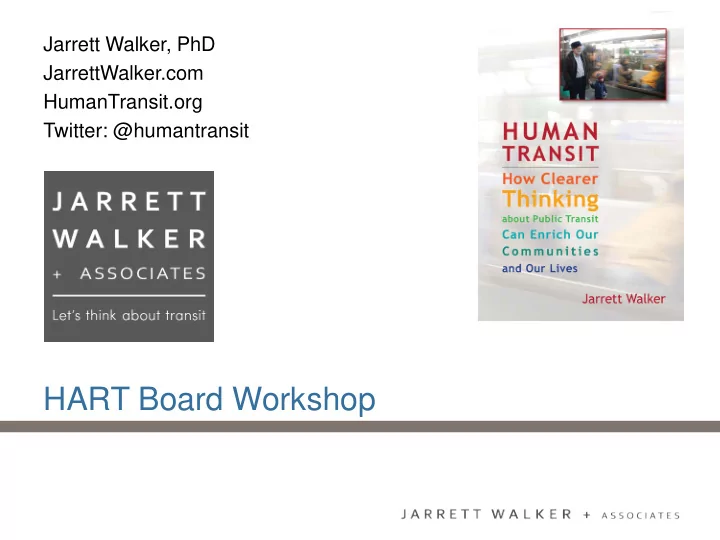

Jarrett Walker, PhD JarrettWalker.com HumanTransit.org Twitter: @humantransit HART Board Workshop
Ultimately, it’s about Space
Ultimately, it’s about Space • Technology never changes geometry! Taxi / Uber Bus Private Car Driverless Car Driverless Bus?
Ultimately, it’s about Space We will always have room for these …
And about labor (pre automation) Operating cost is > 70% labor!
The Wall Around Your Life
Where can I go in 45 minutes?
existing network
proposed network
Jane can get to: 95, 95,000 000 more j jobs ( (+43% +43%) 149, 49,000 m 000 more r res esidents ( (+68% +68%)
Transport Planning Is Freedom Planning • Transport planning: – The process of securing our freedom to do anything require traveling faster than walking. • Freedom is inside of: – Real estate value – Social inclusion / equity – General prosperity
The Geometry of Freedom
The Ridership Recipe • Maximize freedom, which means: • High frequency service … • … following patterns of ... – Density – Walkability – Linearity Why? Because this is how you bring the most useful destinations within reasonable travel time of the most people.
Freedom is a geometric fact. Social Geometry Science Network Freedom Ridership But freedom is the foundation of ridership.
Why Frequency Matters Frequency is the most neglected element of transit. Frequency is a “cubed” benefit: • Go when you want to go. • Make connections easily, to get to more places. • Less risk of being stranded by a disruption.
High frequency High ridership/cost 15 30 60 min min min Higher Productivity (Boardings/Hour) Higher Frequency
Frequent Buses Affordability • Useful enough to be liberating, and • Can’t drive up housing prices everywhere. • Helps build apartments with less parking affordability
Frequent buses tend toward permanence, support redevelopment. Portland: Frequent bus- orientated development (low or zero parking)
But you have to draw and promote the frequent network clearly.
A Map of Our Choices
Complexity. Focus on direct services rather than offering connections. A complex, infrequent network . Abundant access Connections. Make connections easy, through good facilities, and short waits achieved through frequency or pulses.
Not far. Run service very close to every home or destination. . Abundant How far will people walk? access Further to better service. Provide high quality service that’s worth walking further to get to.
Peak First. Design the network around peak needs, treating all-day as secondary . Abundant Peak or All Day? access All Day First. Build all-day service that supports low car ownership, better urban form. Then add peak service as demand warrants.
Start with the peak, or all day?
No. Run in mixed traffic where congestion is high, making reliability impossible. . Abundant Protect from congestion? access Yes . Give transit a path around congestion, so that it can run fast and reliably.
Specialized. Different services for different “types of people” Abundant Diversity or Specialization? access Diverse. Maximize the diversity of people who will find each service useful.
Goal. Focus on the technology as an end in itself, sacrificing access for an emotional or symbolic impact. Abundant Technology: tool or goal? access Tool. Select technologies only for their ability to efficiently provide the greatest possible access.
Coverage. Serve everyone, even where few people will ride. . Abundant Ridership or Coverage? access Ridership. Focus service where ridership potential is high. Offer little service where ridership potential is low.
The Ridership-Coverage Tradeoff Is Ridership What You Want?
Both goals are important, … but they lead opposite directions! Ridership Goal Coverage Goal • “Think like a business.” • “Think like a public service.” • Focus where ridership • “Access for all” potential is highest. • Support low-density • Support dense and development. walkable development. • Lifeline access for everyone. • Max. competition with cars • Service to every member city • Maximum VMT reduction or electoral district.
So it helps to choose a point on the spectrum … Ridership Goal Coverage Goal
In Houston, For Example • Existing network was 55% ridership, 45% coverage. • Board went through process of thinking about alternatives – More customers and more screaming. • Board chose 80% / 20%. • Plan designed to that goal.
We know this geometrically!
Jarrett Walker Blog: HumanTransit.org Twitter: @humantransit Thank you!
Land Use Drivers of Ridership • Density • Walkability • Linearity • Proximity
Density How many people are going to and from the area around each stop? High Ridership Lower Ridership
Can the people around the stop Walkability walk to the stop? High Ridership Lower Ridership
Can transit run in straight lines that are Linearity useful to through-riders? High Ridership Lower Ridership
Does transit have to cross long Proximity low-Ridership gaps? High Ridership Lower Ridership
Recommend
More recommend